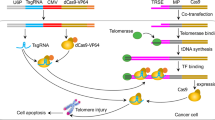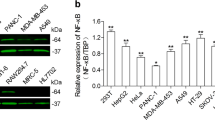Abstract
Purpose
Telomerase reverse transcriptase (hTERT) is the key determinant of telomerase activity and plays a crucial role in cellular immortalization and oncogenesis. It will be a promising target for cancer gene therapy. We constructed a novel replicative adenovirus CNHK300 in which hTERT promoter with three extra E-boxes downstream of the promoter was introduced and used to regulate adenoviral E1a gene, and studied its properties of selective replication in cancer cells and antitumoral activity.
Methods
Luciferase assay was used to detect hTERT promoter activity. The selective replication of CNHK300 in cancer cells was investigated by E1a Western blot and green fluorescent protein (GFP) reporter gene assay. The antitumoral activity of CNHK300 and its toxicity were measured on animal models.
Results
Luciferase assay showed that introducing extra E-boxes downstream of hTERT promoter is beneficial to decreasing the promoter activity in normal cells without affecting its strong activity in cancer cells. Experiments in vitro and in vivo demonstrated that CNHK300 can selectively target to hTERT-positive cancer cells and replicate in them, resulting in oncolytic or antitumoral effect. CNHK300 is superior to ONYX-015 in terms of selective replication and oncolytic or antitumoral effect. The toxicity assay showed no signs of toxicity to liver cells even at the higher dosage of CNHK300 in vivo.
Conclusion
The hTERT promoter-controlled, replication-competent adenovirus CNHK300 is a promising system for targeted cancer gene therapy.









Similar content being viewed by others
References
Abdul-Ghani R, Ohana P, Matouk I, Ayesh S, Ayesh B, Laster M, Bibi O, Giladi H, Molnar-Kimber K, Sughayer MA, De Groot N, Hochberg A (2000) Use of transcriptional regulatory sequences of telomerase (hTER and hTERT) for selective killing of cancer cells. Mol Ther 2:539–544
Alemany R, Balague C, Curiel DT (2000) Replicative adenoviruses for cancer therapy. Nat Biotechnol 18:723–727
Bischoff JR, Kirn DH, Williams A, Heise C, Horn S, Muna M, Ng L, Nye JA, Sampson-Johannes A, Fattaey A, McCormick F (1996) An adenovirus mutant that replicates selectively in p53-deficient human tumor cells. Science 274:373–376
Chiu CP, Dragowska W, Kim NW, Vaziri H, Yui J, Thomas TE, Harley CB, Lansdorp PM (1996) Differential expression of tolemerase activity in hematopoietic progenitors from adult human bone marrow. Stem Cells 14:239–248
Cong YS, Wen J, Bacchetti S (1999) The human telomerase catalytic subunit hTERT: organization of the gene and characterization of the promoter. Hum Mol Genet 8:137–142
Eickbush TH (1997) Telomerase and retrotransposons: which came first? Science 277:911–912
Fujimoto K, Kyo S, Takakura M, Kanaya T, Kitagawa Y, Itoh H, Takahashi M, Inoue M (2000) Identification and characterization of negative regulatory elements of the human telomerase catalytic subunit (hTERT) gene promoter: possible role of MZF-2 in transcriptional repression of hTERT. Nucleic Acids Res 28:2557–2562
Ganly I, Kirn D, Eckhardt G, Rodriguez GI, Soutar DS, Otto R, Robertson AG, Park O, Gulley ML, Heise C, Von Hoff DD, Kaye SB, Eckhardt SG (2000) A phase I study of Onyx-015, an E1B attenuated adenovirus, administered intratumorally to patients with recurrent head and neck cancer. Clin Cancer Res 6:798–806
Greenberg RA, O’Hagan RC, Deng H, Xiao Q, Hann SR, Adams RR, Lichtsteiner S, Chin L, Morin GB, Depinho RA (1999) Telomerase reverse transcriptase gene is a direct target of c-myc but is not functionally equivalent in cellular transformation. Oncogene 18:1219–1926
Gu J, Kagawa S, Takakura M, Kyo S, Inoue M, Roth JA, Fang B (2000) Tumor-specific transgene expression from the human telomerase reverse transcriptase promoter enables targeting of the therapeutic effects of the bax gene to cancers. Cancer Res 60:5359–5364
Gu J, Andreeff M, Roth JA, Fang B (2002) hTERT promoter induces tumor-specific Bax gene expression and cell killing in syngenic mouse tumor model and prevents systemic toxicity. Gene Ther 9:30–37
Gunes C, Lichtsteiner S, Vasserot AP, Englert C (2000) Expression of the hTERT gene is regulated at the level of transcriptional initiation and repressed by Mad1. Cancer Res 60:2116–2121
Harada JN, Berk AJ (1999) p53-Independent and -dependent requirements for E1B-55 K in adenovirus type 5 replication. J Virol 73:5333–5344
Hernandez-Alcoceba R, Pihalja M, Qian D, Clarke MF (2002) New oncolytic adenoviruses with hypoxia- and estrogen receptor-regulated replication. Human Gene Ther 13:1737–1750
Hodes R (2001) Molecular targeting of cancer: telomeres as targets. Proc Natl Acad Sci USA 98:7649–7651
Horikawa I, Cable PL, Afshari C, Barrett JC (1999) Cloning and characterization of the promoter region of human telomerase reverse transcriptase gene. Cancer Res 59:826–830
Horikawa I, Cable PL, Mazur SJ, Appella E, Afshari CA, Barrett JC (2002) Downstream E-box-mediated regulation of the human telomerase reverse transcriptase (hTERT) gene transcription: evidence for an endogenous mechanism of transcriptional repression. Mol Biol Cell 13:2585–2597
Huang TG, Savontaus MJ, Shinozaki K, Sauter BV, Woo SLC (2003) Telomerase-dependent oncolytic adenovirus for cancer treatment. Gene Ther 10:1241–1247
Irving J, Wang Z, Powell S, O’Sullivan C, Mok M, Murphy B, Cardoza L, Lebkowski JS, Majumdar AS (2004) Conditionally replicative adenovirus driven by the human telomerase promoter provides broad-spectrum antitumor activity without liver toxicity. Cancer Gene Ther 11:174–185
Johnson L, Shen A, Boyle L, Kunich J, Pandey K, Lemmon M, Hermiston T, Giedlin M, McCormick F, Fattaey A (2002) Selectively replicating adenoviruses targeting deregulated E2F activity are potent, systemic antitumor agents. Cancer Cell 1:325–337
Kawashima T, Kagawa S, Kobayashi N, Shirakiya Y, Umeoka T, Teraishi F, Taki M, Kyo S, Tanaka N, Fujiwara T (2004) Telomerase-specific replication-selective virotherapy for human cancer. Clin Cancer Res 10:285–292
Khuri FR, Nemunaitis J, Ganly I, Arseneau J, Tannock IF, Romel L, Gore M, Ironside J, Macdougall RH, Heise C, Randlev B, Gillenwater AM, Bruso P, Kaye SB, Hong WK, Kirn DH (2000) A controlled trial of intratumoral ONYX-015, a selectively-replicating adenovirus, in combination with cisplatin and 5-fluorouracil in patients with recurrent head and neck cancer. Nat Med 6:879–885
Kim NW, Piatyszek MA, Prowse KR, Harley CB, West MD, Ho PL, Coviello GM, Wright WE, Weinrich SL, Shay JW (1994) Specific association of human telomerase activity with immortal cells and cancer. Science 266:2011–2015
Kirn D, Martuza RL, Zwiebel J (2001) Replication-selective virotherapy for cancer: biological principles, risk management and future directions. Nat Med 7:781–787
Koga S, Hirohata S, Kondo Y, Komata T, Takakura M, Inoue M, Kyo S, Kondo S (2000) A novel telomerase-specific gene therapy: gene transfer of caspase-8 utilizing the human telomerase catalytic subunit gene promoter. Hum Gene Ther 11:1397–1406
Kurihara T, Brough DE, Kovesdi I, Kufe DW (2000) Selectivity of a replication-competent adenovirus for human breast carcinoma cells expressing the MUC1 antigen. J Clin Invest 106:763–771
Kyo S, Takakura M, Taira T, Kanaya T, Itoh H, Yutsudo M, Ariga H, Inoue M (2000) Sp1 cooperates with c-Myc to activate transcription of the human telomerase reverse transcriptase gene (hTERT). Nucleic Acids Res 28:669–677
LaBarre DD, Lowy RJ (2001) Improvements in methods for calculating virus titer estimates from TCID50 and plaque assays. J Virol Methods 96:107–126
Nakayama J, Tahara H, Tahara E, Saito M, Ito K, Nakamura H, Nakanishi T, Tahara E, Ide T, Ishikawa F (1998) Telomerase activation by hTRT in human normal fibroblasts and hepatocellular carcinomas. Nat Genet 18:65–68
Nowak J, Januszkiewicz D, Lewandowski K, Nowicka-Kujawska K, Pernak M, Rembowska J, Nowak T, Wysocki J (2003) Activity and expression of human telomerase in normal and malignant cells in gastric and colon cancer patients. Eur J Gastroenterol Hepatol 15:75–80
Ohashi M, Kanai F, Tateishi K, Taniguchi H, Marignani PA, Yoshida Y, Shiratori Y, Hamada H, Omata M (2001) Target gene therapy for alpha-fetoprotein-producing hepatocellular carcinoma by E1B55k-attenuated adenovirus. Biochem Biophys Res Commun 282:529–535
Osaki T, Tanio Y, Tachibana I, Hosoe S, Kumagai T, Kawase I, Oikawa S, Kishimoto T (1994) Gene therapy for carcinoembryonic antigen-producing human lung cancer cells by cell type-specific expression of herpes simplex virus thymidine kinase gene. Cancer Res 54:5258–5261
Peng XY, Won JH, Rutherford T, Fujii T, Zelterman D, Pizzorno G, Sapi E, Leavitt J, Kacinski B, Crystal R, Schwartz P, Deisseroth A (2001) The use of the L-plastin promoter for adenoviral-mediated, tumor-specific gene expression in ovarian and bladder cancer cell lines. Cancer Res 61:4405–4413
Poole JC, Andrews LG, Tollefsbol TO (2001) Activity, function, and gene regulation of the catalytic subunit of telomerase (hTERT). Gene 269:1–12
Ramachandra M, Rahman A, Zou A, Vaillancourt M, Howe JA, Antelman D, Sugarman B, Demers GW, Engler H, Johnson D, Shabram P (2001) Re-engineering adenovirus regulatory pathways to enhance oncolytic specificity and efficacy. Nat Biotechnol 19:1035–1041
Rodriguez R, Schuur ER, Lim HY, Henderson GA, Simons JW, Henderson DR (1997) Prostate attenuated replication competent adenovirus (ARCA) CN706: a selective cytotoxic for prostate-specific antigen-positive prostate cancer cells. Cancer Res 57:2559–2563
Saretzki G, Petersen S, Petersen I, Kolble K, Von Zglinicki T (2002) hTERT gene dosage correlates with telomerase activity in human lung cancer cell lines. Cancer Lett 176:81–91
Shay JW, Bacchetti S (1997) A survey of telomerase activity in human cancer. Eur J Cancer 33:787–791
Takakura M, Kyo S, Kanaya T, Hirano H, Takeda J, Yutsudo M, Inoue M (1999) Cloning of human telomerase catalytic subunit (hTERT) gene promoter and identification of proximal core promoter sequences essential for transcriptional activation in immortalized and cancer cells. Cancer Res 59:551–557
Tsukuda K, Wiewrodt R, Molnar-Kimber K, Jovanovic VP, Amin KM (2002) An E2F-responsive replication-selective adenovirus targeted to the defective cell cycle in cancer cells: potent antitumoral efficacy but no toxicity to normal cell. Cancer Res 62:3438–3447
Weinrich SL, Pruzan R, Ma L, Ouellette M, Tesmer VM, Holt SE, Bodnar AG, Lichtsteiner S, Kim NW, Trager JB, Taylor RD, Carlos R, Andrews WH, Wright WE, Shay JW, Harley CB, Morin GB (1997) Reconstitution of human telomerase with the template RNA component hTR and the catalytic protein subunit hTRT. Nat Genet 17:498–502
Wirth T, Zender L, Schulte B, Mundt B, Plentz R, Rudolph KL, Manns M, Kubicka S, Kühnel (2003) A telomerease-dependent conditionally replicating adenovirus for selective treatment of cancer. Cancer Res 63:3181–3188
Xu D, Wang Q, Gruber A, Bjorkholm M, Chen Z, Zaid A, Selivanova G, Peterson C, Wiman KG, Pisa P (2000) Downregulation of telomerase reverse transcriptase mRNA expression by wild type p53 in human tumor cells. Oncogene 19:5123–5133
Yui J, Chiu CP, Lansdorp PM (1998) Telomerase activity in candidate stem cells from fetal liver and adult bone marrow. Blood 91:3255–3262
Zou W, Luo C, Zhang Z, Liu J, Gu J, Pei Z, Qian C, Liu X (2004) A novel oncolytic adenovirus targeting to telomerase activity in tumor cells with potent. Oncogene 23:457–464
Acknowledgements
We thank J.-Z. Gu and D.-Q. Zhu, Shanghai Experimental Animal Center, Chinese Academy of Sciences, for assistance with animal studies. We also thank Q. Zhang, W.-G. Wang, and Y.-J Liu for typing this article, and H.-P. Wu for assistance with vector construction in our laboratory
Author information
Authors and Affiliations
Corresponding author
Additional information
This work is supported by the International Cooperation Important Project of National Natural Scientific Foundation of China (No. 30120160824) and the State 863 High Technology R&D Project of China (No. 2001AA217031)
Rights and permissions
About this article
Cite this article
Su, CQ., Sham, J., Xue, HB. et al. Potent antitumoral efficacy of a novel replicative adenovirus CNHK300 targeting telomerase-positive cancer cells. J Cancer Res Clin Oncol 130, 591–603 (2004). https://doi.org/10.1007/s00432-004-0577-4
Received:
Accepted:
Published:
Issue Date:
DOI: https://doi.org/10.1007/s00432-004-0577-4




